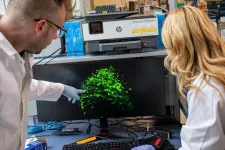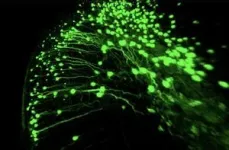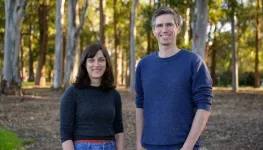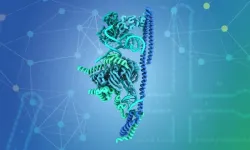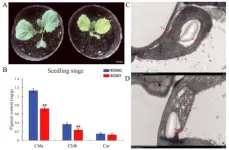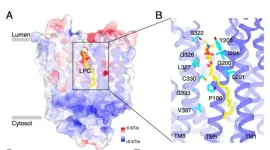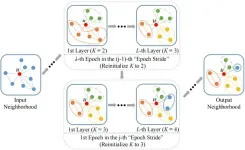(Press-News.org) Take a look around your home and you’ll find yourself surrounded by familiar comforts—photos of family and friends on the wall, well-worn sneakers by the door, a shelf adorned with travel mementos.
Objects like these are etched into our memory, shaping who we are and helping us navigate environments and daily life with ease. But how do these memories form? And what if we could stop them from slipping away under a devastating condition like Alzheimer’s disease?
Scientists at UBC’s faculty of medicine have just uncovered a crucial piece of the puzzle. In a study published today in Nature Communications, the researchers have discovered a new type of brain cell that plays a central role in our ability to remember and recognize objects.
Called ‘ovoid cells,’ these highly-specialized neurons activate each time we encounter something new, triggering a process that stores those objects in memory and allowing us to recognize them months—potentially even years—later.
“Object recognition memory is central to our identity and how we interact with the world,” said Dr. Mark Cembrowski, the study’s senior author, and an associate professor of cellular and physiological sciences at UBC and investigator at the Djavad Mowafaghian Centre for Brain Health. “Knowing if an object is familiar or new can determine everything from survival to day-to-day functioning, and has huge implications for memory-related diseases and disorders.”
Hiding in plain sight
Named for the distinct egg-like shape of their cell body, ovoid cells are present in relatively small numbers within the hippocampus of humans, mice and other animals.
Adrienne Kinman, a PhD student in Dr. Cembrowski’s lab and the study’s lead author, discovered the cells’ unique properties while analyzing a mouse brain sample, when she noticed a small cluster of neurons with highly distinctive gene expression.
“They were hiding right there in plain sight,” said Kinman. “And with further analysis, we saw that they are quite distinct from other neurons at a cellular and functional level, and in terms of their neural circuitry.”
To understand the role ovoid cells play, Kinman manipulated the cells in mice so they would glow when active inside the brain. The team then used a miniature single-photon microscope to observe the cells as the mice interacted with their environment.
The ovoid cells lit up when the mice encountered an unfamiliar object, but as they grew used to it, the cells stopped responding. In other words, the cells had done their jobs: the mice now remembered the objects.
"What’s remarkable is how vividly these cells react when exposed to something new. It’s rare to witness such a clear link between cell activity and behaviour," said Kinman. "And in mice, the cells can remember a single encounter with an object for months, which is an extraordinary level of sustained memory for these animals."
New insights for Alzheimer’s disease, epilepsy
The researchers are now investigating the role that ovoid cells play in a range of brain disorders. The team’s hypothesis is that when the cells become dysregulated, either too active or not active enough, they could be driving the symptoms of conditions like Alzheimer’s disease and epilepsy.
“Recognition memory is one of the hallmarks of Alzheimer’s disease—you forget what keys are, or that photo of a person you love. What if we could manipulate these cells to prevent or reverse that?” said Kinman. “And with epilepsy, we’re seeing that ovoid cells are hyperexcitable and could be playing a role in seizure initiation and propagation, making them a promising target for novel treatments.”
For Dr. Cembrowski, discovering the highly specialized neuron upends decades of conventional thinking that the hippocampus contained only a single type of cell that controlled multiple aspects of memory.
“From a fundamental neuroscience perspective, it really transforms our understanding of how memory works,” he said. “It opens the door to the idea that there may be other undiscovered neuron types within the brain, each with specialized roles in learning, memory and cognition. That creates a world of possibilities that would completely reshape how we approach and treat brain health and disease."
Interview language(s): English
END
Meet the newly discovered brain cell that allows you to remember objects
Discovery of ‘ovoid cells’ reshapes our understanding of how memory works, and could open the door to new treatments for Alzheimer’s disease, epilepsy and more
2025-02-12
ELSE PRESS RELEASES FROM THIS DATE:
Engineered animals show new way to fight mercury pollution
2025-02-12
Australian scientists have found an effective new way to clean up methylmercury, one of the world’s most dangerous pollutants, which often builds up in our food and environment because of industrial activities such as illegal gold mining and burning coal. The discovery, published in Nature Communications on 12 February 2025, could lead to new ways of engineering animals to protect both wildlife and human health.
The research team from Macquarie University's Applied BioSciences, CSIRO, Macquarie Medical School, and the ARC Centre of Excellence in Synthetic Biology, has successfully genetically modified fruit flies and zebrafish to transform methylmercury into a ...
The 3,000-year coral reef shutdown: a mysterious pause and a remarkable recovery
2025-02-12
New study reveals that coral reefs in the Gulf of Eilat experienced a surprising 3,000-year "shutdown" in growth, from about 4,400 to 1,000 years ago, likely due to a temporary drop in sea level that could have been caused by global cooling. This phenomenon, which aligns with similar reef interruptions in Mexico, Brazil, and Australia, suggests a widespread environmental shift during that period. Despite the long pause, the reef eventually recovered, with coral species reappearing from deeper ...
Worm surface chemistry reveals secrets to their development and survival
2025-02-12
A new study has revealed the clearest-ever picture of the surface chemistry of worm species that provides groundbreaking insights into how animals interact with their environment and each other. These discoveries could pave the way for strategies to deepen our understanding of evolutionary adaptations, refine behavioural research, and ultimately overcome parasitic infections.
Scientists from the University’s School of Pharmacy used an advanced mass spectrometry imaging system to examine the nematodes Caenorhabditis elegans and Pristionchus pacificus, aiming to characterise species-specific surface chemical ...
Splicing twins: unravelling the secrets of the minor spliceosome complex
2025-02-12
In human cells, only a small proportion of the information written in genes is used to produce proteins. How does the cell select this information? A large molecular machine called the spliceosome continuously separates the coding and non-coding regions of our genes – and it's doing this even as you read these lines.
The spliceosome is critical for the proper functioning of every cell, and numerous genetic disorders are linked to problems with spliceosome function. In most eukaryotic cells, two types of ...
500-year-old Transylvanian diaries show how the Little Ice Age completely changed life and death in the region
2025-02-12
Glaciers, sediments, and pollen can be used to reconstruct the climate of the past. Beyond ‘nature’s archive,’, other sources, such as diaries, travel notes, parish or monastery registers, and other written documents – known at the ‘society’s archive’ – contain reports and observations about local climates in bygone centuries.
In contrast, the second half of the century was characterized by heavy rainfall and floods, particularly in the 1590s.
The western parts of the European continent cooled significantly when in the 16th century a period known as the ‘Little Ice Age’ intensified. During the second ...
Overcoming nicotine withdrawal: Clues found in neural mechanisms of the brain
2025-02-12
According to the World Health Organization (WHO), over 22% of the global population smokes, with more than 9 million smoking-related deaths reported annually. Effective treatments to alleviate nicotine withdrawal symptoms caused by smoking cessation are essential for successful smoking cessation. Currently, approved treatments for nicotine withdrawal include Bupropion and Varenicline, but there is a pressing need for new therapeutic options to improve smoking cessation success rates.
The research team led by Dr. Heh-In Im at the Center for Brain Disorders of the Korea Institute of Science and Technology (KIST) has identified a novel brain region and neural mechanism ...
Survey: Women prefer female doctors, but finding one for heart health can be difficult
2025-02-12
EMBARGOED UNTIL WEDNESDAY, FEBRUARY 12, 2025
Mountain View, CA (Feb. 12, 2025) – According to the U.S. Physician Workforce Data Dashboard, only about 17% of cardiologists are women, ranking as one of the lowest specialties among female physicians, yet heart disease remains the number one killer of women, accounting for one in five female deaths. El Camino Health is innovating a solution to address the unique symptoms and risk factors of heart disease in women.
A new national survey conducted by El Camino Health found women (59%) are ...
Leaf color mysteries unveiled: the role of BoYgl-2 in cabbage
2025-02-12
A new study has uncovered a novel P-type PPR protein, BoYgl-2, which plays a crucial role in chloroplast RNA editing and chlorophyll biosynthesis in cabbage. This discovery sheds new light on the molecular mechanisms governing leaf color formation and chloroplast development, filling a significant knowledge gap in plant physiology. By identifying a spontaneous yellow-green leaf mutant and deciphering the function of BoYgl-2, the research paves the way for innovative crop breeding strategies that could enhance plant productivity and agricultural sustainability.
Leaf color is more than just an aesthetic trait—it is a vital agronomic characteristic ...
NUS Medicine study: Inability of cells to recycle fats can spell disease
2025-02-12
Accumulation of fat molecules is detrimental to the cell. Researchers from the Yong Loo Lin School of Medicine, National University of Singapore (NUS Medicine), have made a breakthrough in understanding how our cells manage to stay healthy by recycling important fat molecules. Their study, published in the journal Proceedings of the National Academy of Sciences (PNAS), reveals how a protein called Spinster homolog 1 (Spns1) helps transport fats out of cell compartments known as lysosomes.
Led by Associate Professor Nguyen Nam Long, from the Department of Biochemistry and Immunology Translational Research Programme (TRP) at NUS Medicine, the team found that Spns1 is like a cellular ...
D2-GCN: a graph convolutional network with dynamic disentanglement for node classification
2025-02-12
Classic Graph Convolutional Networks (GCNs) often learn node representation holistically, which would ignore the distinct impacts from different neighbors when aggregating their features to update a node's representation. Disentangled GCNs have been proposed to divide each node's representation into several feature channels. However, current disentangling methods do not try to figure out how many inherent factors the model should assign to help extract the best representation of each node.
To solve the problems, a research team led by Chuliang WENG published their new ...
LAST 30 PRESS RELEASES:
Pusan National University researchers discover faster, smarter heat treatment for lightweight magnesium metals
China’s 2024 Gastroenterology Report: marked progress in endoscopy quality and disease management
Pusan National University researchers uncover scalable method for ultrahigh-resolution quantum dot displays
Researchers use robotics to find potential new antibiotic among hundreds of metal complexes
Gut bacteria changes at the earliest stages of inflammatory bowel disease
Scientists develop new way to “listen in” on the brain’s hidden language
Brain research: “Pulse generators” grow and shrink as memories are formed
For teens, any cannabis use may have impact on emotional health, academic performance
School meals could unlock major gains for human and planetary health
Menopause hormone therapy does not appear to impact dementia risk
Signature patterns of brain activity may help predict recovery from traumatic brain injury
Dresden study uncovers new key mechanism in cancer cells
New species are now being discovered faster than ever before, study suggests
Cannabis-based products show limited short-term benefit for chronic pain, with increased risk of adverse effects
Cannabis products with more THC slightly reduce pain but cause more side effects
Clearing the brain of aging cells could aid epilepsy and reduce seizures
Brain injuries linked with potential risk of suicide, new study finds
New technique lights up where drugs go in the body, cell by cell
New study finds movement of fishing fleets can reveal shifts in marine ecosystems
Embargoed: New evidence points to potential treatment for vascular dementia
Study uncovers disrupted brain balance in alcohol dependence
Working in groups can help Republicans and Democrats agree on controversial content moderation online
Structural findings reveal how distinct GPCR ligands create different levels of activation
Anything-goes “anyons” may be at the root of surprising quantum experiments
UC review: Maximizing workplace opportunity for veterans
From generation to complex control: Metasurfaces make perfect vortex beams "within reach"
Thin-film lithium niobate-based detector: recent advances and perspectives
Exploring why some people may tend to persistently make bad choices
How cells balance their protein levels
Nirsevimab vs RSVpreF vaccine for RSV–related hospitalization in newborns
[Press-News.org] Meet the newly discovered brain cell that allows you to remember objectsDiscovery of ‘ovoid cells’ reshapes our understanding of how memory works, and could open the door to new treatments for Alzheimer’s disease, epilepsy and more
